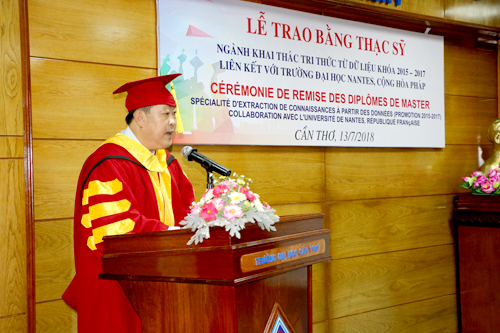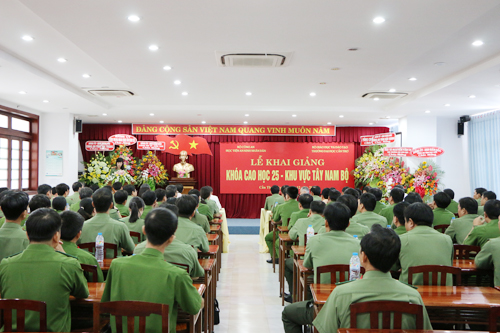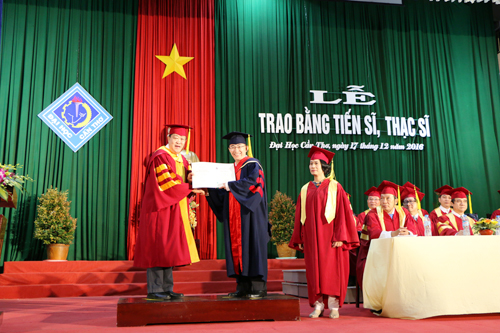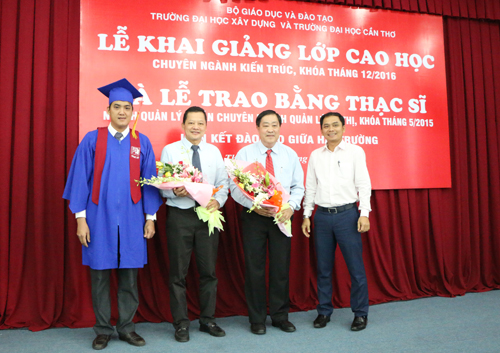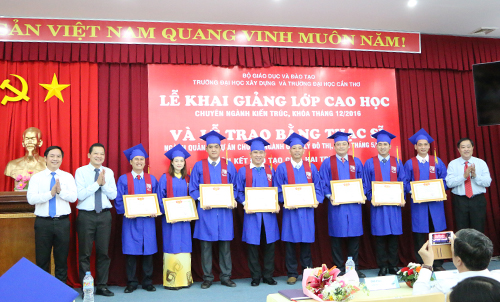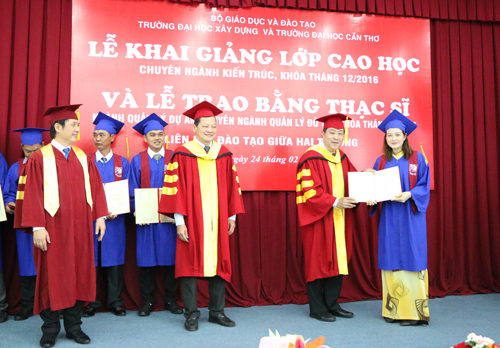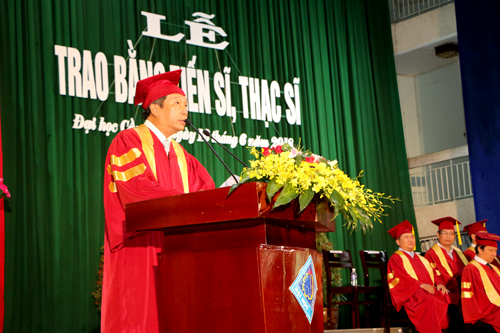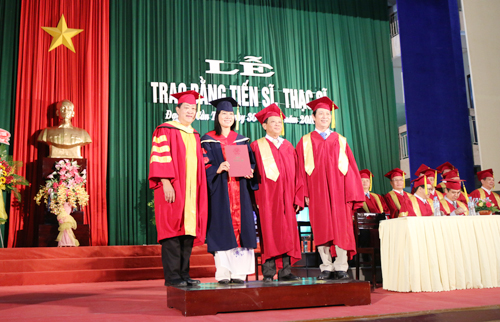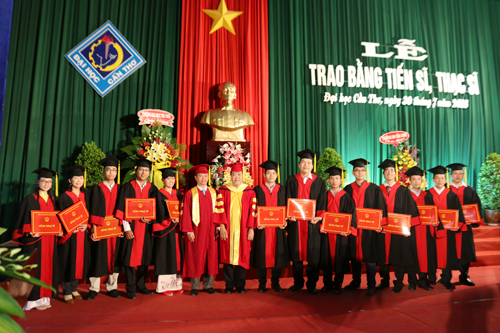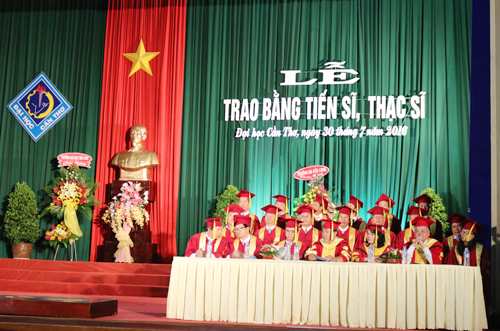
Tên đề tài: “Nghiên cứu quy trình công nghệ sản xuất sinh khối hệ sợi nấm mối (Termitomyces sp.)”.
Tác giả: Nguyễn Thị Ngọc Nhi, Khóa: 2015
Chuyên ngành: Công nghệ sinh học; Mã số: 62420201. Nhóm ngành: Khoa học sự sống
Người hướng dẫn chính: PGS.TS. Trần Nhân Dũng - Trường Đại học Cần Thơ
- Tóm tắt nội dung luận án
Luận án “ Nghiên cứu quy trình công nghệ sản xuất sinh khối hệ sợi nấm mối (Termitomyces sp.)” được thực hiện nhằm mục tiêu thiết lập một qui trình nuôi cấy sản xuât thử nghiệm sinh khối hệ sợi nấm mối T. clypeatus trong hệ thống nuôi cấy sinh học (bioreactor) 60L. Kết quả dựa trên khảo sát hình thái của quả thể nấm và khuẩn lạc, kết hợp giải trình tự gen các đoạn IST1, 5S và IST2 đặc trưng của nấm cho thấy bảy chủng nấm mối phân lập được đều thuộc chi Terminomyces, trong đó có hai chủng đã định danh được đến loài là T. clypeatus (N1) và T. microcarpus (BD). Nghiên cứu sản xuất thử nghiệm trên loài nấm mối T. clypeatus cho thấy môi trường nhân giống cấp một thích hợp cho sự phát triển của loài nấm này là môi trường có chứa KH2PO4 (0,1%), pepton (0,2%), glucose (4%), yeast extract (0,1%), MgSO4 (0,015%), thời gian nuôi tối ưu là 20 ngày. Trong khi đó môi trường nhân giống cấp 2 có khác biệt gồm gồm tỷ lệ chủng giống 10% v/v với chế độ sục khí 0,4 v/v/m. Một qui trình sản xuất thử nghiệm nuôi sinh khối hệ sợi nấm mối T. clypeatus đã được thiết lập trên hệ thống nuôi cấy sinh học với bình nuôi thể tích 60L. Kết quả khảo sát cho thấy các điều kiện tối thích cho sinh khối hệ sợi phát triển mạnh là tỉ lệ giống chủng vào môi trường nuôi cấy 5% (v/v), pH 5,0, lượng khí sục là 0,4 v/v/m, tốc độ khuấy 180 vòng/phút, nhiệt độ môi trường 28oC. Lượng sinh khối thu nhận là 6,633±0,041 g/L. Sinh khối sợi nấm tươi (93,9% ẩm độ) có chứa protein (3,75%), carbohydrate (1,76%), acid amin tổng (2,16%) bao gồm các acid amin thiết yếu như valine, leucine, isoleucine, threonine, phenylalanine, lysine, arginine, histidine. Cao chiết methanol sinh khối khô hệ sợi nấm T. clypeatus có thể trung hòa gốc tự do DPPH với IC50 trung bình 2,26 mg/mL, ở nồng độ 5 mg/mL có thể ức chế lên đến 71,65-83,52% gốc tự do DPPH. Bên cạnh đó cao chiết này cũng có khả năng kháng các vi khuẩn gây bệnh như Bacillus cereus ATCC 11778, Candida albicans ATCC 10231, Pseudomonas aeruginosa ATCC 27853 và Staphylococcus aureus ATCC 6538 với MIC là 10,98 mg/mL. Độc tính của cao chiết cũng được xác định trên tế bào gan người LO-2, kết quả cho thấy tỉ lệ sống của tế bào rất cao (90%) ở nồng độ cao chiết là 2.500 μg/mL. Kết quả xác định độc tính cấp và độc tính bán trường diễn của cao chiết trên chuột cho thấy, trong cả hai trường hợp đều không có chuột tử vong ở liều 10.000 mg/kg thể trọng trong thử nghiệm độc tính cấp, và ở liều 1.000 mg/kg thể trọng trong thử nghiệm độc tính bán trường diễn.
2. Những kết quả mới của luận án
- Đề tài đã phân lập và xác định chi của 07 chủng nấm mối là Termitomyces, trong đó có 2 chủng xác định được đến loài là Termitomyces clypeatus và Termitomyces microcapus.
- Quy trình công nghệ sản xuất sinh khối hệ sợi nấm mối trong Bioreactor 60 lít đã được xây dựng và tìm ra đường cong sinh trưởng của nấm mối Termitomyces clypeatus.
- Các thành phần dinh dưỡng đã được phân tích, hoạt tính kháng khuẩn và chống oxy hóa của sinh khối hệ sợi nấm mối Termitomyces clypeatus đã được đánh giá. Đồng thời sản xuất thành công sinh khối nấm mối và chiết, cô đặc cao để thử nghiệm hoạt tính sinh học, độc tính tế bào, độc tính cấp và độc tính bán trường diễn của sản phẩm cao.
- Khả năng ứng dụng trong thực tiễn, các vấn đề cần tiếp tục nghiên cứu
- Khả năng ứng dụng trong thực tiễn
Kết quả nghiên cứu có ý nghĩa thực tiễn to lớn trong việc sản xuất sinh khối các loại nấm dược liệu, đặc biệt là những loài nấm quý mà con người chưa thể trồng được ra quả thể, thì con đường nuôi cấy dịch thể bằng các bể phản ứng sinh học là một giải pháp hữu hiệu.
- Các vấn đề cần tiếp tục nghiên cứu
Đẩy mạnh các nghiên cứu về phân loại và phân bố của các loài nấm mối ở Việt Nam.
Tiếp tục đẩy mạnh các nghiên cứu chuyên sâu về lĩnh vực sinh học phân tử và cấu trúc vi thể của nấm mối, đây sẽ là nền tản vững chắc để xây dựng hệ thống phân loại cho chi Termitomyces tại Việt Nam.
Phân tích thành phần dược chất có trong môi trường sau khi nuôi cấy để định hướng nghiên cứu sản suất theo hướng thu sinh khối hay thu các sản phẩm thứ cấp.
Thesis title: “Study on the technological process for biomass production of termite mushrooms (Termitomyces sp.)”
Speciality: Biotechnology.
Speciality ID: 62420201.
PhD student: Nguyen Thi Ngoc Nhi
Scientific supervisor: Assoc. Prof. Tran Nhan Dung.
Academic institute: CanTho University
- Thesis summary
The thesis “Studying on mycelium biomass production procedure from Termitomyces sp.” was carried out with the aim of establishing a culture process for experimental production of T. clypeatus mycelium in 60 L Bioreactor. The results based on the morphological survey of fungal fruiting bodies and colonies, combined with gene sequencing of ITS1, 5S and ITS2 fragments that are characteristic of fungi, showed that seven strains of termite mushroom, belonged to the genus Terminomyces, in which there are two strains that have been identified as T. clypeatus (N1) and T. microcarpus (BD). Research on experimental production on the termite mushroom T. clypeatus showed that the primary propagation medium suitable for the growth of this fungus was the medium containing KH2PO4 (0.1%), peptone (0.2%), glucose (4%), yeast extract (0.1%), MgSO4 (0.015%), optimal culture time is 20 days. Meanwhile, the secondary propagation medium was different, including the seed rate of 10% v/v with the aeration mode of 0.4 v/v/m. An experimental production procedure for T. clypeatus mycelium was established on a biological culture system with a cultural tank of 60 liters. The survey results showed that the optimal conditions for the growth of mycelium biomass were the seed rate 5% (v/v), pH 5, aeration mode of 0.4 v/v/m, stirring speed 180 rmp, the temperature of 28ºC. The amount of collected biomass was 6.633±0.041 g/L. Fresh mycelium biomass (93.9% moisture) contains proteins (3.75%), carbohydrates (1.76%), total amino acids (2.16%) including essential amino acids such as valine, leucine, isoleucine, threonine, phenylalanine, lysine, arginine, histidine. The dry biomass methanol extract of mycelium was able to neutralize DPPH free radicals with an average IC50 value of 2.26 mg/mL, at a concentration of 5 mg/mL inhibiting up to 71.65-83.52% DPPH free radicals. Besides, this extract was also resistant to pathogenic bacteria such as Bacillus cereus ATCC 11778, Candida albicans ATCC 10231, Pseudomonas aeruginosa ATCC 27853 and Staphylococcus aureus ATCC 6538 with MIC of 10.98 mg/mL. The toxicity of the extract was also determined on LO-2 hepatocytes, the results indicated extremely high cell survival (90%) at the extract concentration of 2500 mg/mL. The results of determining acute toxicity and semi-permanent toxicity of the extract in rats showed that, in both cases, there was no death of rats at the dose of 10,000 mg/kg body weight in the acute toxicity test, and at the dose of 1,000 mg/kg body weight in the semi-permanent toxicity test.
- The new results of the thesis
- Seven strains of Termitomyces sp. were isolated and sequenced, of which two species were identified with scientific names: Termitomyces clypeatus and Termitomyces microcapus.
- The technological process of producing termite mycelium in Bioreactor 60 liters were recommended for detecting the growth curve of Termitomyces clypeatus.
- The nutritional components were analyzed as well as the antibacterial and antioxidant activities of Termitomyces clypeatus mycelium were evalusted. Simultaneously, Termitomyces biomas was produced for testing biological activity, cytotoxicity, acute toxicity, and semi-permanent toxicity of the extract.
- Practical application and suggestions for further study
- Practical application
The result has devoted practical significance in the biomass manufacturing of medicinal mushrooms, especially those precious mushrooms which fruiting bodies haven’t been growth. Thus, bioreactor systems are a viable solution.
- Suggestions for further study
Research on taxonomy and distribution of termite fungus species in Vietnam.
Invesment on specialized studies in molecular biology and microstructure of termite fungi, which will be a solid foundation for the construction of a taxonomy system for the Termitomyces genus.
Analysis of pharmaceutical ingredients in the media after culture to orient production research towards collecting biomass or collecting secondary products.
- Xem chi tiết nội dung luận án
- Xem thông tin đăng tải tại Website Bộ giáo dục và Đào tạo. (Nhập tên NCS vào ô tìm kiếm)





